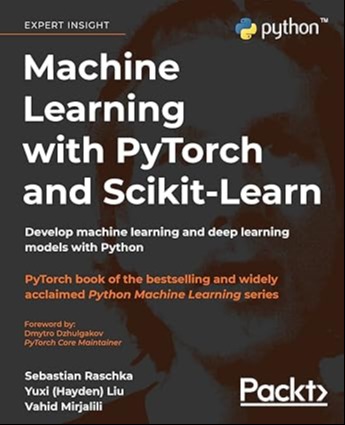Machine Learning with PyTorch and Scikit-Learn: A Comprehensive Guide
Introduction
Machine learning (ML) and deep learning (DL) have revolutionized various industries, from healthcare to finance. Python, with its rich ecosystem of libraries like PyTorch and Scikit-learn, has become the de facto language for ML and DL development. This white paper aims to provide a comprehensive guide to building ML and DL models using these powerful tools.
Part I: Foundational Concepts
1.1. Core Machine Learning Concepts
- Supervised Learning: Learning from labeled data to make predictions.
- Regression: Predicting continuous numerical values (e.g., house prices).
- Classification: Predicting categorical labels (e.g., email spam detection).
- Unsupervised Learning: Learning patterns from unlabeled data.
- Clustering: Grouping similar data points together (e.g., customer segmentation).
- Dimensionality Reduction: Reducing the number of features in a dataset (e.g., PCA).
- Reinforcement Learning: Learning through trial and error, interacting with an environment.
1.2. Introduction to PyTorch
- Tensor Operations: The fundamental building block of PyTorch.
- Automatic Differentiation: Efficiently calculating gradients for optimization.
- Neural Networks: Building and training neural networks with PyTorch.
- Data Loading and Preprocessing: Handling and preparing data for model training.
1.3. Introduction to Scikit-learn
- Data Preprocessing: Cleaning, scaling, and transforming data.
- Model Selection: Choosing appropriate algorithms for different tasks.
- Model Evaluation: Assessing model performance using metrics like accuracy, precision, recall, and F1-score.
- Hyperparameter Tuning: Optimizing model
Part II: Building Machine Learning Models with Scikit-learn
2.1. Linear Regression
- Simple Linear Regression: Modeling the relationship between two variables.
- Multiple Linear Regression: Modeling the relationship between a dependent variable and multiple independent variables.
2.2. Logistic Regression
- Binary Classification: Predicting binary outcomes (e.g., spam or not spam).
- Multi-class Classification: Predicting multiple classes (e.g., image classification).
2.3. Decision Trees and Random Forests
- Decision Trees: Tree-based models for classification and regression.
- Random Forests: Ensemble models combining multiple decision trees.
2.4. Support Vector Machines (SVMs)
- Linear SVMs: Classifying data using hyperplanes.
- Kernel SVMs: Extending SVMs to non-linearly separable data.
2.5. Clustering Algorithms
- K-Means Clustering: Grouping data points into clusters based on similarity.
- Hierarchical Clustering: Creating a hierarchy of clusters.
Part III: Building Deep Learning Models with PyTorch
3.1. Feedforward Neural Networks
- Building Basic Neural Networks: Creating layers, activations, and loss functions.
- Training Neural Networks: Using optimization algorithms like SGD and Adam.
- Regularization Techniques: Preventing overfitting (e.g., dropout, L1/L2 regularization).
3.2. Convolutional Neural Networks (CNNs)
- Convolutional Layers: Extracting features from images.
- Pooling Layers: Reducing spatial dimensions.
- Building CNN Architectures: Designing effective CNN architectures for image classification, object detection, and image segmentation.
3.3. Recurrent Neural Networks (RNNs)
- Handling Sequential Data: Processing sequences of data (e.g., time series, text).
- Long Short-Term Memory (LSTM) Networks: Addressing the vanishing gradient problem.
- Gated Recurrent Units (GRUs): A simplified version of LSTMs.
3.4. Generative Adversarial Networks (GANs)
- Generator and Discriminator Networks: Training two networks to generate realistic data.
- Applications of GANs: Image generation, style transfer, and data augmentation.
Part IV: Advanced Topics
4.1. Transfer Learning
- Leveraging Pre-trained Models: Using pre-trained models as a starting point.
- Fine-tuning: Adapting pre-trained models to specific tasks.
4.2. Model Deployment
- Deploying Models to Production: Using frameworks like Flask, FastAPI, and TensorFlow Serving.
- Model Monitoring and Maintenance: Tracking model performance and retraining as needed.
References
Books:
- Machine Learning with PyTorch and Scikit-Learn by Sebastian Raschka and Vahid Mirjalili
- Hands-On Machine Learning with Scikit-Learn, Keras, and TensorFlow by Aurélien Géron
- Deep Learning with PyTorch by Eli Stevens, Luca Antiga, and Thomas Viehmann
Websites and Online Resources:
- PyTorch Official Documentation: https://scikit-learn.org/
- Kaggle: https://machinelearningmastery.com/
- Towards Data Science:
Video Courses:
- Udemy:
- [Course Name 1]
- [Course Name 2]
- Packt:
- [Course Name 1]
- [Course Name 2]
Additional Tips
- Practice Regularly: Build projects to gain hands-on experience.
- Experiment with Different Techniques: Try different algorithms and hyperparameters.
- Stay Updated: Follow the latest research and trends in ML and DL.
- Collaborate with Others: Learn from others and share your knowledge.
- Join Online Communities: Participate in forums and discussions.
By following this comprehensive guide and leveraging the powerful tools of PyTorch and Scikit-learn, you can embark on a successful journey into the world of machine learning and deep learning.



